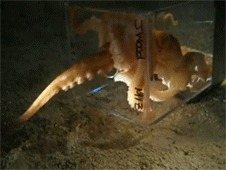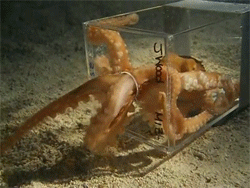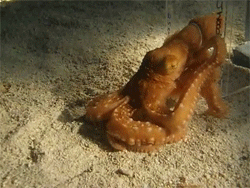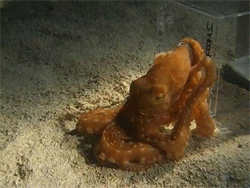The @unirdg-collections Squint
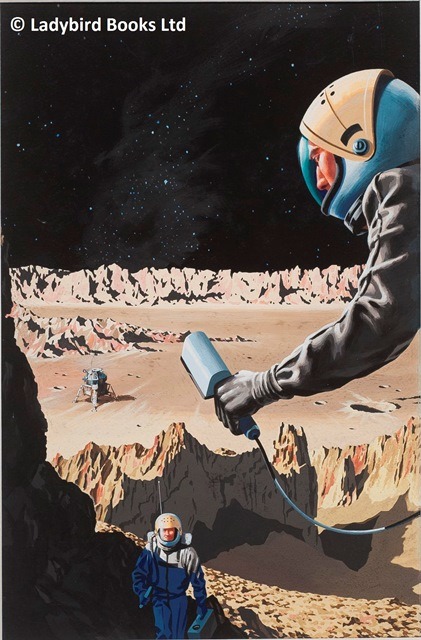
The @unirdg-collections Squint
The University of Reading holds the archive of original artwork for the much-loved Ladybird children’s book. This painting on board was used to illustrate Exploring Space, a Ladybird ‘Achievements’ Book first published in 1964. The artwork was created by Brian Knight.

If you look closely at the painting, you can see the faint trace of Knight’s initial design for the lunar landing module - just visible under the later amendment.

Published before the first Moon landing in 1969, the fantasy spacecraft was sleek and utopian. It typifies the extent to which The Space Race captured our mid-century imaginations and permeated visual culture. The later correction, based on the Eagle Lunar Module, was printed in subsequent revisions to the book. It was an acknowledgment of a successful mission and testament to Ladybird’s emphasis on accuracy for its young readers.

All artwork is © Ladybird Books Ltd.
More Posts from Philosophical-amoeba and Others
The code that took America's Apollo 11 to the moon in the 1960's has been published

When programmers at the MIT Instrumentation Laboratory set out to develop the flight software for the Apollo 11 space program in the mid-1960s, the necessary technology did not exist. They had to invent it.
They came up with a new way to store computer programs, called “rope memory,” and created a special version of the assembly programming language. Assembly itself is obscure to many of today’s programmers—it’s very difficult to read, intended to be easily understood by computers, not humans. For the Apollo Guidance Computer (AGC), MIT programmers wrote thousands of lines of that esoteric code.
Here’s a very 1960s data visualization of just how much code they wrote—this is Margaret Hamilton, director of software engineering for the project, standing next to a stack of paper containing the software:

The AGC code has been available to the public for quite a while–it was first uploaded by tech researcher Ron Burkey in 2003, after he’d transcribed it from scanned images of the original hardcopies MIT had put online. That is, he manually typed out each line, one by one.
“It was scanned by an airplane pilot named Gary Neff in Colorado,” Burkey said in an email. “MIT got hold of the scans and put them online in the form of page images, which unfortunately had been mutilated in the process to the point of being unreadable in places.” Burkey reconstructed the unreadable parts, he said, using his engineering skills to fill in the blanks.
“Quite a bit later, I managed to get some replacement scans from Gary Neff for the unreadable parts and fortunately found out that the parts I filled in were 100% correct!” he said.
As enormous and successful as Burkey’s project has been, however, the code itself remained somewhat obscure to many of today’s software developers. That was until last Thursday (July 7), when former NASA intern Chris Garry uploaded the software in its entirety to GitHub, the code-sharing site where millions of programmers hang out these days.
Within hours, coders began dissecting the software, particularly looking at the code comments the AGC’s original programmers had written. In programming, comments are plain-English descriptions of what task is being performed at a given point. But as the always-sharp joke detectives in Reddit’s r/ProgrammerHumor section found, many of the comments in the AGC code go beyond boring explanations of the software itself. They’re full of light-hearted jokes and messages, and very 1960s references.
One of the source code files, for example, is called BURN_BABY_BURN--MASTER_IGNITION_ROUTINE, and the opening comments explain why:

About 900 lines into that subroutine, a reader can see the playfulness of the original programming team come through, in the first and last comments in this block of code:

In the file called LUNAR_LANDING_GUIDANCE_EQUATIONS.s, it appears that two lines of code were meant to be temporary ended up being permanent, against the hopes of one programmer:

In the same file, there’s also code that appears to instruct an astronaut to “crank the silly thing around.”

“That code is all about positioning the antenna for the LR (landing radar),” Burkey explained. “I presume that it’s displaying a code to warn the astronaut to reposition it.”
And in the PINBALL_GAME_BUTTONS_AND_LIGHTS.s file, which is described as “the keyboard and display system program … exchanged between the AGC and the computer operator,” there’s a peculiar Shakespeare quote:
This is likely a reference to the AGC programming language itself, as one Reddit user . The language used predetermined “nouns” and “verbs” to execute operations. The verb pointed out 37, for example, means “Run program,” while the noun 33 means “Time to ignition.”
Now that the code is on GitHub, programmers can actually suggest changes and file issues. And, of course, they have

On this day, 6th May 1840, the first adhesive postage stamp in the world, the Penny Black, came into official use in Great Britain.
It depicted a portrait of Queen Victoria and stamps continued with her image until her death in 1901. All British stamps still show the monarch somewhere on the design. They are the only postage stamps in the world that do not indicate a country of origin; the monarch’s image symbolises the United Kingdom.
The Penny Black lasted less than a year. A red cancellation was hard to see on the black design and the red ink was easy to remove; both made it possible to re-use cancelled stamps. In February 1841, the Treasury switched to the Penny Red and began using black ink for cancellations instead, which was more effective and harder to remove.
The State Library of New South Wales holds significant postage stamp collections, which include a number of penny black stamps -
Sir William Dixson Stamp Collection
1840 One Penny black Queen Victoria Recess printed Watermark Small Crown Imperf ( 1 mint, 3 used, 1 forgery ) and
DP/M014 Series 02: Sir William Dixson Stamp Collection : Great Britain and Commonwealth Countries issued to 1952 Great Britain 1840
1840 One Penny black Recess printed Watermark Small Crown Imperf ( 6 used ) DP/M010 :- Box with miscellaneous items mounted on pages, numbered DP/M011 to DP/M127
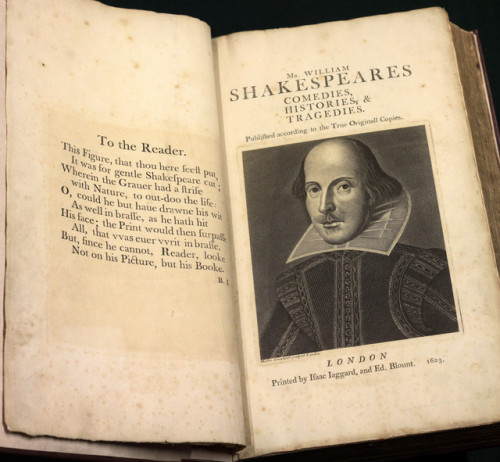
Comedies Histories Tragedies
Mr William Shakespeare
London Iaggard and Blount 1623
Textual reprint of the First Folio published by J Wright 1807

Prevalence of homosexuality in men is stable throughout time since many carry the genes
Around half of all heterosexual men and women potentially carry so-called homosexuality genes that are passed on from one generation to the next. This has helped homosexuality to be present among humans throughout history and in all cultures, even though homosexual men normally do not have many descendants who can directly inherit their genes. This idea is reported by Giorgi Chaladze of the Ilia State University in Georgia, and published in Springer’s journal Archives of Sexual Behavior. Chaladze used a computational model that, among others, includes aspects of heredity and the tendency of homosexual men to come from larger families.
Chaladze, G. Heterosexual Male Carriers Could Explain Persistence of Homosexuality in Men: Individual-Based Simulations of an X-Linked Inheritance Model. Archives of Sexual Behavior, 2016 DOI: 10.1007/s10508-016-0742-2

The song “It’s a long way to Tipperary” was enormously popular in New Zealand as a sound recording sung by Stanley Kirkby, with shops advertising new arrivals of stock from overseas in early 1915. At the same time, a film of the same title was also being shown in cinemas, and sheet music for an orchestral arrangement was available at the “Golden Horn” music store in Vivian Street Wellington. Copies of this Maori postcard with its “Tipirere “ translation were handed out to members of the 2nd Maori Contingent of the New Zealand Expeditionary Force after they marched through the streets of Wellington on Saturday 16 September 1915 (See Evening Post, 20 September 1915, page 8).
[Postcard]. Tipirere. N.Z.M.E.C. Hokowhitu-a-Tu. [ca 1915].
Eph-B-POSTCARD-Vol-12-003-btm

(Image caption: If this picture makes you feel uncomfortable, you feel empathic pain. This sensation activates the same brain regions as real pain. © Kai Weinsziehr for MPG)
The anatomy of pain
Grimacing, we flinch when we see someone accidentally hit their thumb with a hammer. But is it really pain we feel? Researchers at the Max Planck Institute for Human Cognitive and Brain Sciences in Leipzig and other institutions have now proposed a new theory that describes pain as a multi-layered gradual event which consists of specific pain components, such as a burning sensation in the hand, and more general components, such as negative emotions. A comparison of the brain activation patterns during both experiences could clarify which components the empathic response shares with real pain.
Imagine you’re driving a nail into a wall with a hammer and accidentally bang your finger. You would probably injure finger tissue, feel physical distress, focus all your attention on your injured finger and take care not to repeat the misfortune. All this describes physical and psychological manifestations of “pain” – specifically, so-called nociceptive pain experienced by your body, which is caused by the stimulation of pain receptors.
Now imagine that you see a friend injure him or herself in the same way. You would again literally wince and feel pain, empathetic pain in this case. Although you yourself have not sustained any injury, to some extent you would experience the same symptoms: You would feel anxiety; you may recoil to put distance between yourself and the source of the pain; and you would store information about the context of the experience in order to avoid pain in the future.
Activity in the brain
Previous studies have shown that the same brain structures – namely the anterior insula and the cingulate cortex – are activated, irrespective of whether the pain is personally experienced or empathetic. However, despite this congruence in the underlying activated areas of the brain, the extent to which the two forms of pain really are similar remains a matter of considerable controversy.
To help shed light on the matter, neuroscientists, including Tania Singer, Director at the Max Planck Institute for Human Cognitive and Brain Sciences in Leipzig, have now proposed a new theory: “We need to get away from this either-or question, whether the pain is genuine or not.”
Instead, it should be seen as a complex interaction of multiple elements, which together form the complex experience we call “pain”. The elements include sensory processes, which determine, for example, where the pain stimulus was triggered: in the hand or in the foot? In addition, emotional processes, such as the negative feeling experienced during pain, also come into play. “The decisive point is that the individual processes can also play a role in other experiences, albeit in a different activation pattern,” Singer explains – for example, if someone tickles your hand or foot, or you see images of people suffering on television. Other processes, such as the stimulation of pain receptors, are probably highly specific to pain. The neuroscientists therefore propose comparing the elements of direct and empathetic pain: Which elements are shared and which, by contrast, are specific and unique to the each form of pain?
Areas process general components
A study that was published almost simultaneously by scientists from the Max Planck Institute for Human Cognitive and Brain Sciences and the University of Geneva has provided strong proof of this theory: They were able to demonstrate for the first time that during painful experiences the anterior insula region and the cingulate cortex process both general components, which also occur during other negative experiences such as disgust or indignation, and specific pain information – whether the pain is direct or empathic.
The general components signal that an experience is in fact unpleasant and not joyful. The specific information, in turn, tells us that pain – not disgust or indignation – is involved, and whether the pain is being experienced by you or someone else. “Both the nonspecific and the specific information are processed in parallel in the brain structures responsible for pain. But the activation patterns are different,” says Anita Tusche, also a neuroscientist at the Max Planck Institute in Leipzig and one of the authors of the study.
Thanks to the fact that our brain deals with these components in parallel, we can process various unpleasant experiences in a time-saving and energy-saving manner. At the same time, however, we are able register detailed information quickly, so that we know exactly what kind of unpleasant event has occurred – and whether it affects us directly or vicariously. “The fact that our brain processes pain and other unpleasant events simultaneously for the most part, no matter if they are experienced by us or someone else, is very important for social interactions,” Tusche says, “because it helps to us understand what others are experiencing.”










Staff Pick of the Week
As a lover of mythology and folklore, my first staff pick is The Wonder-Smith and His Son, by Ella Young (1867-1956), with illustrations by Boris Artzybasheff (1899-1965). It was published by Longmans, Green Co. in 1927 and was a Newbery Honor recipient in 1928. The book is a collection of myths from Ireland and Scotland about a legendary wonder smith known as the Gubbaun Saor, a “maker of worlds and a shaper of universes.” There are fourteen stories in the collection, detailing how the Gubbaun Saor got his world-building abilities, which involved finding a bag of magical tools that were dropped from the sky by a bird. The book also includes tales about his adopted son Lugh and his daughter Aunya. In her memoir, Flowering Dusk: Things Remembered Accurately and Inaccurately, Young wrote “I have a fondness for The Wonder-Smith; perhaps because I did not invent the stories in the book. I gathered them through twenty-five years of searching, and put a thread of prose round them.” The folktales were collected from story-tellers in Clare, Achill Island, Aranmore, and the Curraun.
Ella Young’s interest in Celtic mythology led to her becoming involved with the growing Irish nationalist movement. Many nationalist writers and artists were looking to Ireland’s history and legends for inspiration, and she befriended fellow Irish writers Æ (George William Russell), Padraic Colum, and William Butler Yeats. Æ called her “a druidess reincarnated.” Aside from publishing poetry and folklore, Yong was also involved in running guns and ammunition to the Irish Republican Army, and was a member of Cumann na mBAn, a women’s paramilitary organization that took part in the 1916 Easter Rising. She continued to write throughout the war, and in 1925 embarked for America to do a speaking tour about Celtic mythology at universities across the country. She was eventually granted American citizenship and accepted a teaching position at the University of California, Berkeley. Often described as mystical and otherworldly, Young lived out the rest of her life near the California coast writing and publishing stories and sharing her love of folklore with those around her.
Ukrainian illustrator Boris Artzybasheff fled the Russian Revolution for the United States in 1919. Beginning his career as an engraver, Artzybasheff soon became a book illustrator, some of which he wrote himself, such as Seven Simeons: A Russian Tale, which received a Caldecott Honor award in 1938. He is best known for his magazine covers, and he created over 200 covers for Time magazine alone. Over the course of his career his work evolved to become wonderfully surrealist, he loved anthropomorphizing machines so they would have human attributes and emotions. Even his commercial work in advertising has elements of the absurd. I believe Artzybasheff’s playfulness is evident in the woodcuts he did for The Wonder-Smith, and his illustrations are what drew me to the book.
– Sarah, Special Collections Undergraduate Assistant
Sasando
pic: wikipedia

The sasando is a harp-like musical instrument from East Nusa Tenggara, Indonesia, specifically in the island of Rote. The name is derived from the Rote dialect word “sasandu” meaning “vibrating or sounded instrument.” It can have 28 or 56 strings.
There’s a folktale that explained the origins of the sasando. Once, there was a boy called Sangguana who lived in Rote. One day, he was tired and fell asleep under a palmyra tree, and dreamt that he played beautiful music with a unique instrument that made an enchanting sound. When he woke up, Sangguana was able to vividly remember the melody he played in the dream. He wanted to hear it once more, so he slept again, and dreamt of the same song and the same instrument. Sangguana had to wake up, eventually, but, not wanting to lose the instrument from his dream, he made an instrument out of palmyra leaves based on the one he saw in his dream, which became the basis for the sasando.
if you want to see how it sounds: (start 0:30)

Rockfleet Castle, Co. Mayo, Ireland. It’s a former home of Grace O`Malley (Gráinne Mhaol), the famous 16th century ‘Pirate Queen’.
Photo: Mikeoem (CC-BY-SA-4.0 )
-
 autiearterotica1 liked this · 7 years ago
autiearterotica1 liked this · 7 years ago -
 joshuajadon liked this · 8 years ago
joshuajadon liked this · 8 years ago -
 futurismoldvision reblogged this · 8 years ago
futurismoldvision reblogged this · 8 years ago -
 dsiskokidd liked this · 8 years ago
dsiskokidd liked this · 8 years ago -
 littleplasticspaceship reblogged this · 9 years ago
littleplasticspaceship reblogged this · 9 years ago -
 kfa-tpa-blog liked this · 9 years ago
kfa-tpa-blog liked this · 9 years ago -
 monicafuchs-blog liked this · 9 years ago
monicafuchs-blog liked this · 9 years ago -
 burning-down-the-earth-blog liked this · 9 years ago
burning-down-the-earth-blog liked this · 9 years ago -
 niihhe-blog liked this · 9 years ago
niihhe-blog liked this · 9 years ago -
 jonassoares2001-blog reblogged this · 9 years ago
jonassoares2001-blog reblogged this · 9 years ago -
 jonassoares2001-blog liked this · 9 years ago
jonassoares2001-blog liked this · 9 years ago -
 jonassoares2001-blog reblogged this · 9 years ago
jonassoares2001-blog reblogged this · 9 years ago -
 cwizkhalifa-blog liked this · 9 years ago
cwizkhalifa-blog liked this · 9 years ago -
 misskimia liked this · 9 years ago
misskimia liked this · 9 years ago -
 what-is-done-cannot-be-undone reblogged this · 9 years ago
what-is-done-cannot-be-undone reblogged this · 9 years ago -
 what-is-done-cannot-be-undone liked this · 9 years ago
what-is-done-cannot-be-undone liked this · 9 years ago -
 janmalee liked this · 9 years ago
janmalee liked this · 9 years ago -
 memyselfiamweird reblogged this · 9 years ago
memyselfiamweird reblogged this · 9 years ago -
 othmeralia liked this · 9 years ago
othmeralia liked this · 9 years ago -
 jesluvsun liked this · 9 years ago
jesluvsun liked this · 9 years ago -
 scvpubliclib reblogged this · 9 years ago
scvpubliclib reblogged this · 9 years ago -
 brightonmuseums liked this · 9 years ago
brightonmuseums liked this · 9 years ago -
 aliens-versus-words-blog liked this · 9 years ago
aliens-versus-words-blog liked this · 9 years ago -
 manolorool-blog liked this · 9 years ago
manolorool-blog liked this · 9 years ago -
 julyadg-blog liked this · 9 years ago
julyadg-blog liked this · 9 years ago -
 sweetiepiejanae liked this · 9 years ago
sweetiepiejanae liked this · 9 years ago -
 http-bieberidk-blog liked this · 9 years ago
http-bieberidk-blog liked this · 9 years ago -
 alejandrosanz20-blog liked this · 9 years ago
alejandrosanz20-blog liked this · 9 years ago -
 sspring-awakeningg-blog liked this · 9 years ago
sspring-awakeningg-blog liked this · 9 years ago -
 nextdoriskearns liked this · 9 years ago
nextdoriskearns liked this · 9 years ago -
 rajar28464-blog liked this · 9 years ago
rajar28464-blog liked this · 9 years ago -
 archiveonepageatatime liked this · 9 years ago
archiveonepageatatime liked this · 9 years ago -
 dazednconfusedthings-blog liked this · 9 years ago
dazednconfusedthings-blog liked this · 9 years ago -
 tamayrs liked this · 9 years ago
tamayrs liked this · 9 years ago -
 lottereinigerforever liked this · 9 years ago
lottereinigerforever liked this · 9 years ago -
 supraspectra reblogged this · 9 years ago
supraspectra reblogged this · 9 years ago -
 supraspectra liked this · 9 years ago
supraspectra liked this · 9 years ago -
 doctom666 liked this · 9 years ago
doctom666 liked this · 9 years ago -
 dranor44 liked this · 9 years ago
dranor44 liked this · 9 years ago -
 digbygroks reblogged this · 9 years ago
digbygroks reblogged this · 9 years ago -
 digbygroks liked this · 9 years ago
digbygroks liked this · 9 years ago -
 isabellacardozo-blog1 liked this · 9 years ago
isabellacardozo-blog1 liked this · 9 years ago -
 tehawesomeness reblogged this · 9 years ago
tehawesomeness reblogged this · 9 years ago -
 itsashamepeoplesuck liked this · 9 years ago
itsashamepeoplesuck liked this · 9 years ago -
 reads-randomly reblogged this · 9 years ago
reads-randomly reblogged this · 9 years ago
A reblog of nerdy and quirky stuff that pique my interest.
291 posts
